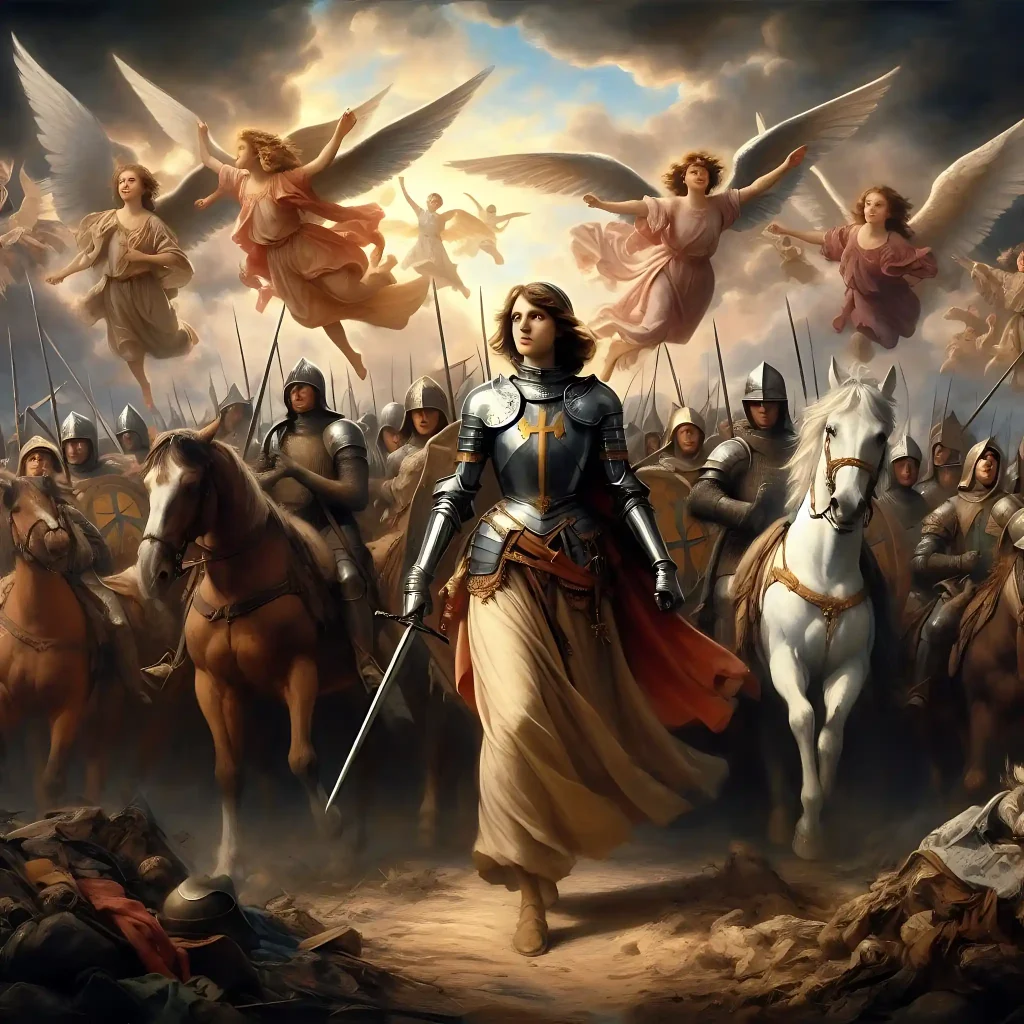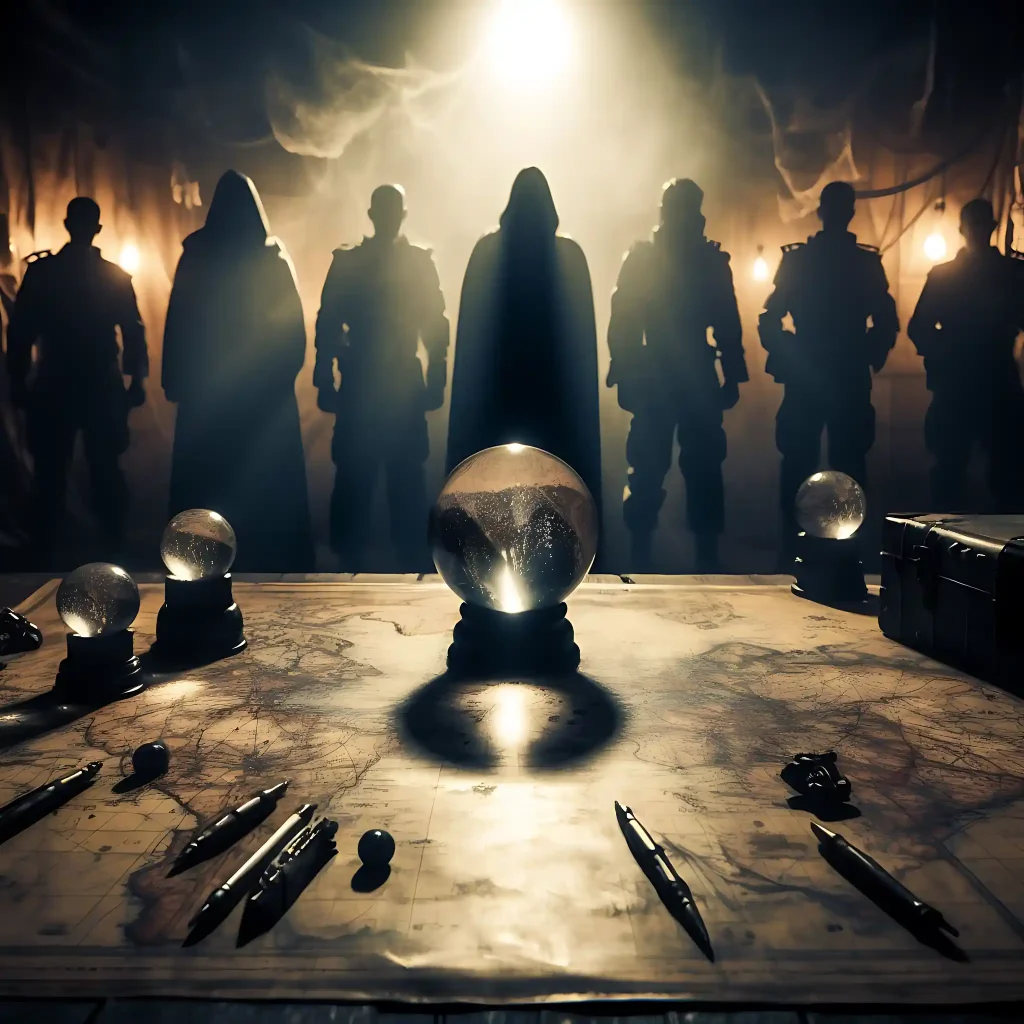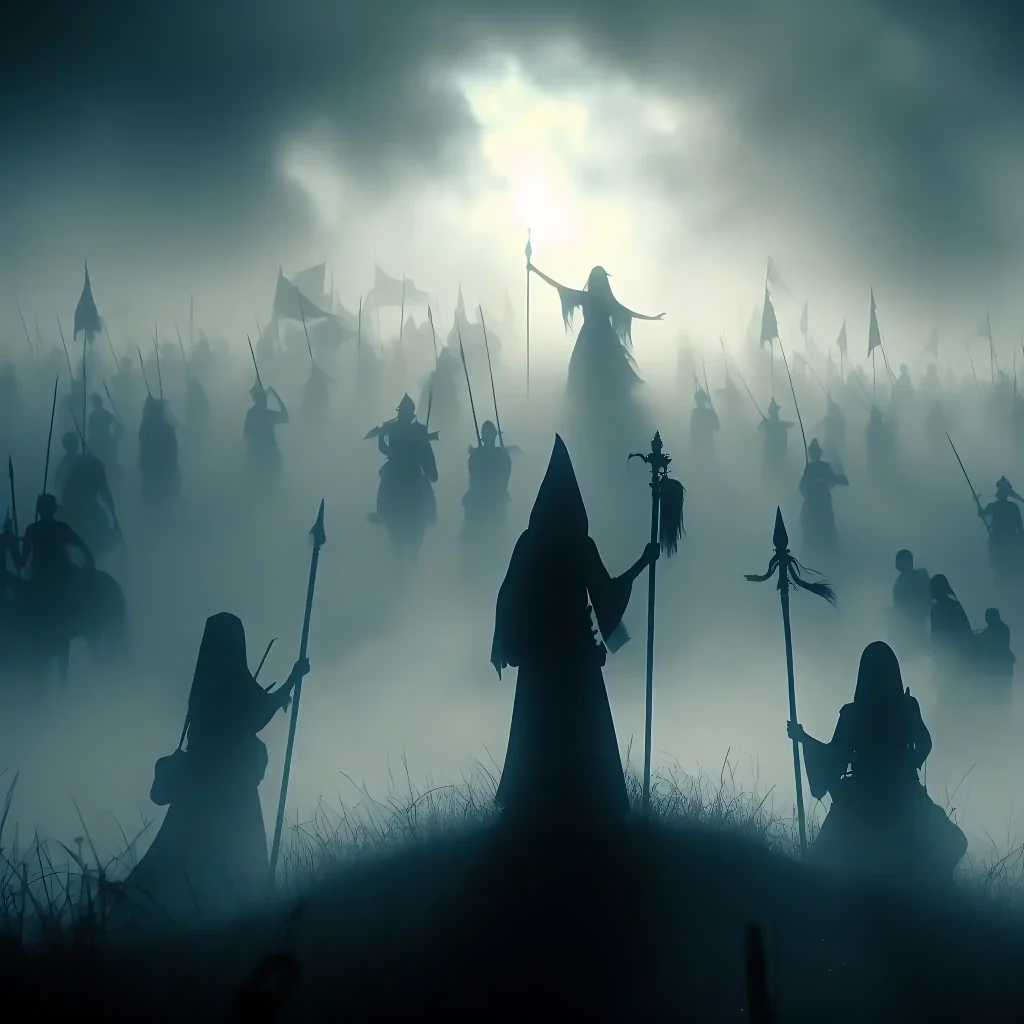The clang of swords collides with the crackle of arcane energy. From the swirling mists emerge mysterious figures, their eyes aglow with power. These are no ordinary soldiers marching to battle, but witches supposedly wielding sorcery to shift the tide of war throughout history. Legends tell of curses muttered over enemy camps, fog summoned to hide advancing troops, storms whipped into being to smash armadas…and those are only the beginning.
While such tales often blur the line between myth and reality, evidence exists of witchcraft intertwined with warfare stretching back to ancient times. We find accounts scattered across cultures – from Joan of Arc blessed by divine voices as she rallied French armies against the English, to Nordic volvas casting spells to inflame Viking raids. And who knows whether the infamous Bell Witch of Tennessee folklore really did prophesy the future Battle of New Orleans?
The pages of history hold many more intriguing cases of magic wielded for martial means. What compelled groups across eras to call upon occult forces through rituals and spellcraft? Did they truly harness paranormal powers or simply inspire belief among the ranks? Let us delve into the age-old legends of these battle witches, how their mystical aid turned battles, and why we continue telling stories of sorcery upon the battlefield today.
Famous Accounts of Witches in Warfare
Joan of Arc: Maid of Orleans Aided by Prophecies in Battle
Joan of Arc stands tall in historical witchcraft, heralded as a woman guided by spiritual visions to lead the French to victory during the Hundred Years’ War. Claiming divine guidance from the Archangel Michael, St. Catherine, and St. Margaret, nineteen-year-old Joan convinced Charles VII to allow her to ride with the army against the English in 1429.
Wearing armor and carrying a battle standard, Joan and her witches in warfare gave the troops courage as they triumphed in lifting the Siege of Orléans and went on reclaim territory. Though later captured and burned at the stake on accusations of heresy and witchcraft, she led daring attacks with uncanny precision due to her otherworldly counsel – cementing her legacy as the Maid of Orléans.
Joan demonstrated how prophecies and witch-like powers might shift wars when embraced by armies desperate for an edge. While she tragically faced accusations of sorcery by threatened English and Burgundian forces, her meteoric battlefield rise shows why legends of battle magic continue capturing imaginations centuries later.

Read more about the lore of witches on our exclusive article here.
The Bell Witch’s Battle Prophecy
The folklore surrounding the nefarious Bell Witch includes a startling prophecy tied to the legendary Battle of New Orleans during the War of 1812. As the story goes, this malevolent spirit – said to have plagued the Bell family of Tennessee with poltergeist activity and curses beginning in 1817 – predicted Andrew Jackson’s pivotal victory against the British in January 1815.
The witch allegedly spoke through young Betsy Bell to outline the precise number of British casualties weeks before the battle occurred. While skeptics view such tall tales as invented later by imaginative storytellers, the Bell Witch legend endures as one of America’s most chilling paranormal mysteries.
Through her hauntings and psychic predictions, the witch struck fear into all who encountered her. Her boast of foretelling key details of Jackson’s win – whether true clairvoyance or fabrication – connects America’s obsession with folk magic and witchcraft to bloody struggles for military supremacy. It remains a seminal case of witches in warfare through the power of prophecy if historical accounts bear any substance.
Witchcraft and Sorcery in the Middle Ages
The medieval era holds countless cases of occult magic used in times of war. People accused of witchcraft found their mystical talents turned to military ends whether based in fact or fiction. For instance, the Stedinger peasants in 1233 Germany allegedly made a pact with the devil to defeat troops sent by the papacy through the use of counterfeit rituals.
Records also suggest Silesian sorcerers used love potions and spells to spark rebellions against Germanic rule in Poland during the 13th century. While official church documents portray these mystic rebels as dangerous agents of Satan, modern scholars debate if their fabricated devilish ties concealed early stirrings of Polish nationalism.
Such attributions of battle magic and witchcraft intensified in the Middle Ages, stoked by authorities threatened by peasant revolts and warring pagan groups. Whether grounded in reality or not, the prevalent superstitions regarding witches and war traveled as far as Iceland. Accounts from medieval travellers insist Icelandic pagans shapeshifted into walruses to capsize enemy ships during sea battles along the frigid northern isles.
The swirling legends showcase how charges of historical witchcraft activity quickly attached themselves to any incidence of perceived occult military assistance – whether supernatural feats or mere brazen acts of sedition against rulers of the era.
Practices of Wartime Witchcraft
The legends of witches influencing battles contain chilling descriptions of the magic rituals and practices used to tilt the odds of war. Reports of wartime sorcery include grisly ingredients and dire consequences for those unfortunate to become cursed targets.
Curses and Dark Hexes
Folklore tells of witches administering hideous curses against opposing armies and militias throughout history. Brave soldiers would cower as elders muttered incantations over enemy camps, condemning all within to grisly fates. Some accounts claim plague curses devastated entire battalions, while other hexes invoked bad luck during critical battle maneuvers.
Witches also reputedly conducted rituals to impart otherworldly properties into weapons and armor. Certain medieval warlocks offered blessings to leave enemy blades blunted against protected skin or render opposing marksmen suddenly blinded. Of course, discovering definitive proof of such battlefield curses continues escaping even the most studious magical historians. Still, repeated global examples showcase how deeply people once feared the cursing powers of witches when unleashed amid the tumult of war.
Harnessing the Elements Through Magic
Beyond direct assaults through curses, legends tell of witches harnessing elemental and natural magic to aid friendly forces. Reports from across Scandinavia, Scotland, Africa and beyond describe witches who could summon the fog and storm to hide advancing armies or smash enemy fleets.
Other accounts depict witches in Poland reanimating gusts to send arrows astray from their targets. Even folk tales from America contain Native shamans who communed with animal spirits to assist tribal warriors in battle through heightened senses and stealth. Regardless of validity, the enduring prevalence of these stories underscores how profoundly people once accepted that mastery over the elements proved vital for witches in warfare
Soothsayers, Oracles, and Psychic Spies
Wartime witchcraft manifested not only through direct attacks and manipulation of environments. Magic workers also gained infamy as prophetic spies able to foresee critical details of future battles.
Joan of Arc epitomized this through the divine voices only she could hear, who gave strategic guidance during campaigns. But she was far from the sole account. Nordic volvas and European cunning folk acted as psychic tacticians based on visions granted through scrying, spirit contact, and astrology. During the Early Modern period, authorities even accused enemy witches of using astral projection to literally scout enemy encampments by sending their spirits to gather intelligence.

Such notions of prophetic spycraft through magic exploded further during 20th century conflicts. British warlocks allegedly used ESP to remotely view Nazi operations. The Third Reich invested resources trying to harness preternatural forces, with rumors of planned battalions of clairvoyant stormtroopers. And the Cold War spawned an obsession with psychic engineering on both sides of the Iron Curtain.
While these modern cases await declassification, their historical predecessors demonstrate how the concept of battle magic granted through supernatural awareness profoundly shaped military thinking for centuries. Desperation for any advantage birthed obsession with sorcerous tactics and witches who could see through the fog of war.
The Enduring Legend of Witches in Warfare
In the end, why do tales of witchcraft and warfare continue captivating imagination through the ages? They speak to our undying fascination with the supernatural and its potential to impact history. There is something profoundly tantalizing about occult forces influencing pivotal moments of organized violence to this very day.
The accounts also reveal much about human psychology – particularly how quickly we attack and scapegoat outsider groups in tumultuous times. Labelling rebellious factions or disadvantaged innocents as “witches” offered justification for suppressing those who threatened fragile societal power structures throughout historical conflicts.
Of course, separating truth from fiction remains challenging centuries later. We may never uncover sufficient evidence to conclusively prove medieval witches cursed armadas or Civil War soothsayers truly predicted battles through tarot cards. Yet even if founded in folklore, the prevalence of these cross-cultural stories underscores our timeless enthrallment with magic and intrigue. The legends grant mystique to history’s bloody struggles for dominance and destruction.
So while belief in witchcraft morphs over time, public fascination with its tie to warfare perseveres. And as long as magic and conflict remain, spellbinding new cases adding to the lore of witches in warfare will continue materializing from the chaos. The mystical fusion provides too ripe a breeding ground for tall tales and speculation likely to endure in human minds for centuries more.

And so ends our journey into the shadowy realm of sorcery and soldiering – where history and imagination collide through spine-tingling tales. While we may never fully confirm acts of battle magic so deeply rooted in lore, these ubiquitous stories showcase our innate fascination with the mystical and macabre.
What are your thoughts after learning the legends of witchcraft across various wars over the centuries? Do you believe magic wielders truly influenced pivotal skirmishes and campaigns? Share which cases intrigued you the most or seemed too outlandish to accept as reality.
We want to hear your takes on the phenomenon of magic in warfare! Did this blog post on witches throughout military history spark new insights or just more curiosity? Let us know in the comments below!

